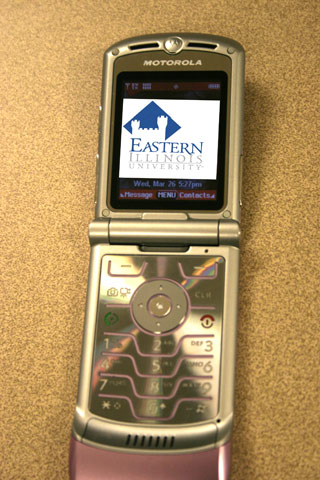University institutes text message program
Eastern now has a text-messaging system in place to notify students of imminent danger on campus, said Dan Nadler, vice president for Student Affairs.
“It’s part of our comprehensive system with regard to emergency notifications to students, faculty and staff,” Nadler said.
The system, called Alert EIU, will alert students, who subscribe to the service, of emergency situations on campus via their cell phones. The messages will be no longer than 160 characters long.
“It’s a really quick method to get at least limited information out to students, faculty and staff and let them know that there is a dangerous situation and they should be alert,” Nadler said.
The text messaging system will be used for life threatening situations, Nadler said. Text messages will only be sent if there is an imminent threat on Eastern’s main campus.
The university has been testing the system recently.
“Two very successful pilot tests have run,” Nadler said.
During the tests messages were sent out to a selective group of Emergency Management Team members, the second test included more members. Most people received their text messages within one minute, Nadler said.
“We have found that those messages went out very efficiently and effectively,” he said.
As of 1:30 p.m. on Wednesday, 235 people had signed up for the service.
Registration requires students or faculty to enter their e-number and ten-digit cell phone number. Users will then receive a confirmation text message letting them know they are signed up for the service, said Clay Hopkins, Eastern’s director of telecommunications.
Conversations about the service have been taking place since the Virginia Tech shooting, which happened April 16, 2007. Last summer the university began researching companies that offered the services and contacting other universities to see which services were used.
The university chose to use Inspiron Logistics Corporation from Ohio. The company provides the service to Southern Illinois University in Carbondale and the University of Akron. The service is costing the university $12,500, Nadler said, and is being paid for by institutional funds, not student fees.
Eastern is not charging students for the service, and any cost involved will be through each individuals calling plan, said Vicki Woodard, Eastern’s director of communications.
Text messaging services are becoming more popular for universities in light of recent school shootings.
“Prior to the NIU event, a third of universities in the United States had text messaging systems,” Hopkins said. “I suspect that has increased and is approaching one half.”
Text messaging systems are useful in emergency situations when phone lines are clogged because of mass usage.
“On a cell phone tower, text messaging is the last to quit,” Hopkins said. “With this system, we are classified as emergency personnel so we are the last of the last to get through.”
When the university decides to use the system, the message will be sent through a secure website.
“Typically, you have a handful of people who are able to send out this emergency alert,” Hopkins said.
Campus police, Nadler, Woodard and Jill Nilsen, vice president for external relations, currently have access to the system.
“If the chief of police was sending out the message, he would sign on to a website, enter a password, enter the message and send the message,” Hopkins said.
The system can send out 30,000 messages in a minute.
Currently, the university is working on a system of pre-programmed messages that would be sent out if a life threatening situation were to occur.
“If an emergency happens, where there is a life threatening situation we would be able to act as quickly as possible,” Nadler said. “Sitting down and composing this message would in essence be a waste of time.”
In the future, the program maybe expanded to be mandatory and include parents but because the program is new, the university is limiting enrollment to current students, faculty and staff.
“There have been conversations about it. Certainly, there are pros and cons to having a voluntary program,” Nadler said. “I think the real test will be how many students sign up on a voluntary basis. “
The university is also discussing a campus-wide cell phone policy, which would allow students to receive text messages from the university while in class, Nadler said. Nadler said students could also be alerted to dangerous situations by the university website, phone tree, or siren and public address system.
“If we push the button on the text messaging system, we want people to know there is imminent danger, that this is the highest classification in a life threatening situation,” Nadler said. “Our goal and our hope is that other than testing it never has to be used.”
Additional information about text messaging program:
In addition to the new text messaging program, the university’s Campus Emergency Notification System includes a siren and public address system, email messages, phone tree and media alerts.
If a student gets a new cell phone, but does not change their phone number they do not have to resubscribe. If a student gets a different phone number they need to unsubscribe and resubscribe for the service. The system will be purged periodically to remove students and staff who have left campus.
Students can subscribe by clicking here.
Nora Maberry can be reached at 581-7942 or at nemaberry@eiu.edu.
University institutes text message program

Eastern students can sign up for the Emergency Notification System, and they will receive text messages notifying them of potential threats. (Photo Illustration by Bryce Peake





































































